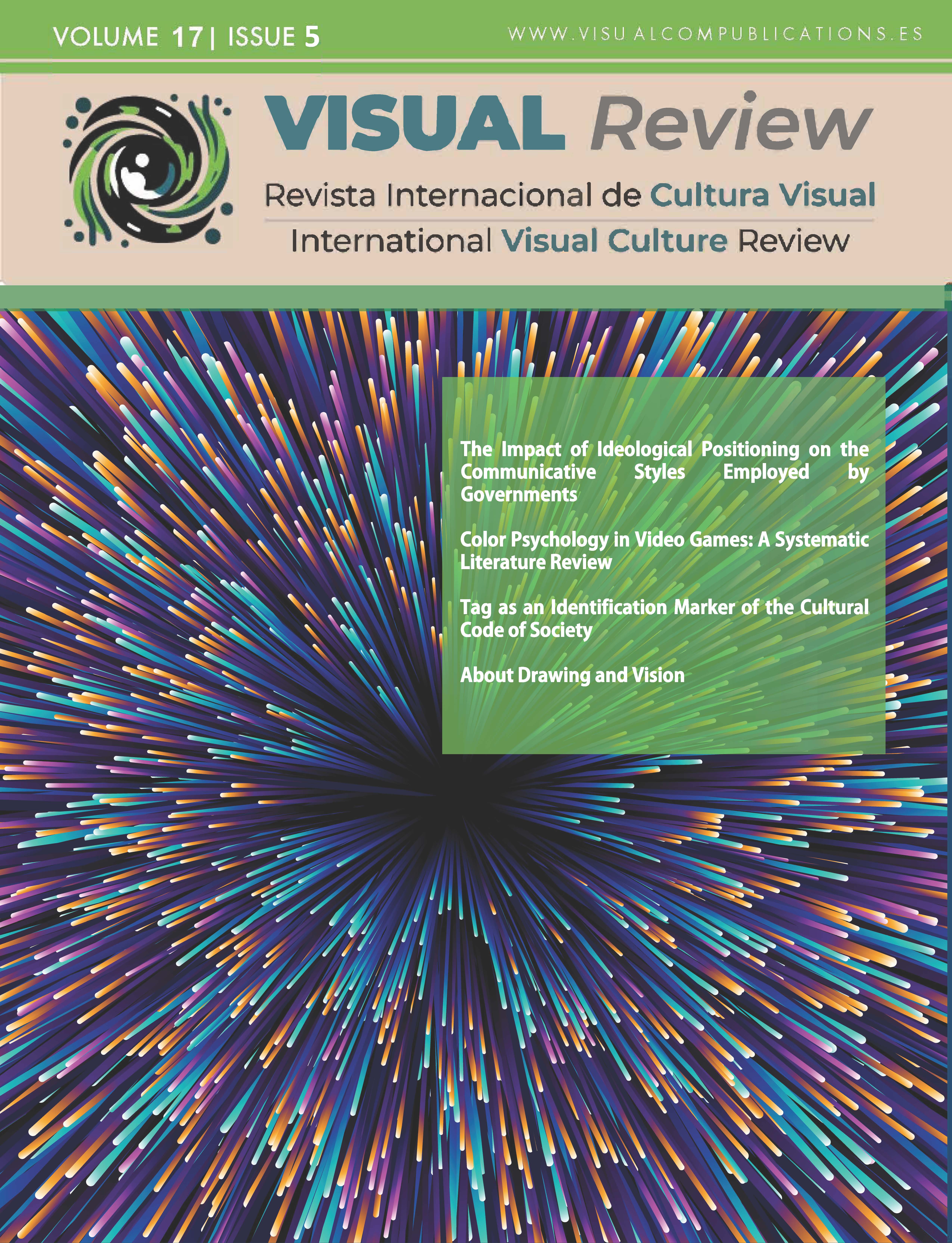Use of Artificial Intelligence Tools in the Reinvention of Narratives on TikTok
DOI:
https://doi.org/10.62161/revvisual.v17.5812Keywords:
Artificial Intelligence, TikTok, AI Filters, Narratives, Mixed Methodologies, Scraping, Visualization, Thematic analysisAbstract
Artificial intelligence (AI) has burst onto TikTok through filters and generative media. This study analyzes 5,000 TikTok videos tagged with #AI, focusing on how AI affects content creation and narratives. Using a mixed method - scanning, visualization, and thematic analysis - we identify the main applications of AI that enhance creativity, personalize content, and blur the boundaries between reality and fiction. Our findings reveal three emerging categories of AI-driven storytelling: rooted content, transformed reality, and new fictional worlds. This research contributes to understanding the evolving role of AI in participatory media and digital culture.
Downloads
Global Statistics ℹ️
|
349
Views
|
110
Downloads
|
|
459
Total
|
|
References
Abidin, C. (2021a). From “Networked Publics” to “Refracted Publics”: A Companion Framework for Researching “Below the Radar” Studies. Social Media + Society, 7(1), 2056305120984458. https://doi.org/10.1177/2056305120984458 DOI: https://doi.org/10.1177/2056305120984458
Abidin, C. (2021b). Mapping Internet Celebrity on TikTok: Exploring Attention Economies and Visibility Labours. Cultural Science Journal, 12(1), 77-103. https://doi.org/https://doi.org/10.5334/csci.140 DOI: https://doi.org/10.5334/csci.140
Alonso L., N., Sidorenko B., P y Giacomelli, F. (2021). Beyond Challenges and Virtual Dance Moves: TikTok as a vehicle for disinformation and fact-checking in Spain, Portugal, Brazil, and the USA. Analisi; Quaderns de Comunicació I Cultura, 64, 65-86. https://doi.org/10.5565/rev/analisi.3411 DOI: https://doi.org/10.5565/rev/analisi.3411
Aulock, I. v. (2024). AI In Content Targeting: A Detailed Guide To Boosting Your Marketing In 2024. Penfriend.ai/blog. Retrieved 2024/12716, from https://penfriend.ai/blog/ai-in-content-targeting
Bhandari, A., & Bimo, S. (2022). Why’s Everyone on TikTok Now? The Algorithmized Self and the Future of Self-Making on Social Media. Social Media + Society, 8(1), 20563051221086241. https://doi.org/10.1177/20563051221086241 DOI: https://doi.org/10.1177/20563051221086241
BotPress_AiBasics. (2023). Ultimate Guide to Artificial Intelligence (AI) and Augmented Reality (AR). Botpress.com. https://botpress.com/blog/ultimate-guide-to-artificial-intelligence-ai-and-augmented-reality-ar
Braun, V., & Clarke, V. (2024). Thematic Analysis. In N. K. Denzin, Y. S. Lincoln, M. D. Giardina, & G. S. U. Cannella (Eds.), The SAGE handbook of qualitative research (Sixth edition. ed., pp. 901-940). SAGE. DOI: https://doi.org/10.4324/9781003362715-21
Carpintero, I. (2023). Cómo crear una imagen de fondo con Inteligencia Artificial con este efecto para TikTok. tuexpertoAPPS.com. Retrieved 2025-01-01, from https://www.tuexpertoapps.com/2023/09/05/como-crear-una-imagen-de-fondo-con-inteligencia-artificial-con-este-efecto-de-tiktok/
Civila, S., & Jaramillo-Dent, D. (2022). #Mixedcouples on TikTok: Performative Hybridization and Identity in the Face of Discrimination. Social Media + Society, 8(3), 20563051221122464. https://doi.org/10.1177/20563051221122464 DOI: https://doi.org/10.1177/20563051221122464
Clark, T., Foster, L., Sloan, L., & Bryman, A. (2021). Bryman's social research methods (Sixth edition. ed.). Oxford University Press.
Creswell, J. W., & Creswell, J. D. (2023). Research design : qualitative, quantitative, and mixed methods approaches (Sixth edition. ed.) [text]. SAGE Publications.
Dahlke, R., Kumar, D., Durumeric, Z., & Hancock, J. T. (2023). Quantifying the Systematic Bias in the Accessibility and Inaccessibility of Web Scraping Content From URL-Logged Web-Browsing Digital Trace Data. Social Science Computer Review, 0(0), 08944393231218214. https://doi.org/10.1177/08944393231218214 DOI: https://doi.org/10.31219/osf.io/bkpqt
Elgammal, A., Liu, B., Elhoseiny, M., & Mazzone, M. (2017). CAN: Creative Adversarial Networks, Generating "Art" by Learning About Styles and Deviating From Style Norms. ArXiv 1706.07068. Retrieved 2017/06/21, from http://arxiv.org/pdf/1706.07068
Eshiet, J. (2020). Real Me versus Social Media Me:” Filters, Snapchat Dysmorphia, and Beauty Perceptions among Young Women. MSc. Thesis, California State University.]. https://scholarworks.lib.csusb.edu/cgi/viewcontent.cgi?article=2243&context=etd
Eugeni, R. (2024). A scanner darkly: augmented reality face filters as algorithmic images. Visual Communication, 23(3), 498-512. https://doi.org/10.1177/14703572241235286 DOI: https://doi.org/10.1177/14703572241235286
Flick, U. (2023). An introduction to qualitative research (7th edition. ed.) [still image]. SAGE.
Georgakopoulou, A. (2016). From Narrating the Self to Posting Self(ies): A Small Stories Approach to Selfies. Open Linguistics, 2(1). https://doi.org/doi:10.1515/opli-2016-0014 DOI: https://doi.org/10.1515/opli-2016-0014
Gillespie, T., Boczkowski, P. J., & Foot, K. A. (2014). Media technologies : essays on communication, materiality, and society. The MIT Press. DOI: https://doi.org/10.7551/mitpress/9780262525374.001.0001
Green, A. (2023). MIT Report on Generative AI. MIT Technology Review Insights, https://bit.ly/3WBQ4kk.
Grove, E. (2024, August 14). Impact Of AI On Cultural Narratives. Raindance. https://raindance.org/impact-of-artificial-intelligence-on-cultural-narratives/
Guzman, A. L., McEwen, R., & Jones, S. (2023). The Sage handbook of human-machine communication. SAGE.
Guzman, A. L., McEwen, R., Jones, S., & Mann, S. (2023). The Sage handbook of human-machine communication. SAGE,. DOI: https://doi.org/10.4135/9781529782783
Hernando Velasco, A., Matsumoto, M., Dominguez-Santos, S., & Lacasa, P. (2024, online first). Digitalization of cultural industries: Evidence from the official Spider-Man movie TikTok account. Convergence, 0(0). https://doi.org/https://doi.org/10.1177/13548565241253904 DOI: https://doi.org/10.1177/13548565241253904
Higuera, A. (2023, 2023-02-27). Este filtro de belleza extrema con IA de TikTok tiene a todos locos: te cambia por completo y es así de real. https://www.20minutos.es/tecnologia/aplicaciones/tiktok-revoluciona-internet-este-impactante-filtro-realista-con-ia-te-cambia-por-completo-5104977/
Ieee. (2024). Artificial Intelligence and Augmented Reality - IEEE Digital Reality. IEEE.org Digital reality. https://digitalreality.ieee.org/publications/artificial-intelligence-and-augmented-reality
Imed Bouchrika, P. (2024). Digital Storytelling: Benefits, Examples, Tools & Tips in 2024 | Research.com. Research.com. Retrieved 2024-12-14, from https://research.com/education/digital-storytelling
Isakowitsch, C. (2023). How Augmented Reality Beauty Filters Can Affect Self-perception. In L. Longo & R. O’Reilly, Artificial Intelligence and Cognitive Science Cham. DOI: https://doi.org/10.1007/978-3-031-26438-2_19
Kang, H., & Lou, C. (2022). AI agency vs. human agency: understanding human–AI interactions on TikTok and their implications for user engagement. Journal of Computer-Mediated Communication, 27(5). https://doi.org/10.1093/jcmc/zmac014 DOI: https://doi.org/10.1093/jcmc/zmac014
Kaswan, K. S. (2024). Cyborg : Human and Machine Communication Paradigm (First edition. ed.). CRC Press,. DOI: https://doi.org/10.1201/9781003392699
Koç, B. (2023a). The Role of User Interactions in Social Media on Recommendation Algorithms: Evaluation of TikTok's Personalization Practices From User's Perspective Istanbul University. https://www.researchgate.net/publication/375775130_The_Role_of_User_Interactions_in_Social_Media_on_Recommendation_Algorithms_Evaluation_of_TikTok's_Personalization_Practices_From_User's_Perspective
Koç, B. (2023b). The Role of User Interactions in Social Media on Recommendation Algorithms: Evaluation of TikTok's Personalization Practices From User's Perspective https://www.researchgate.net/publication/375775130_The_Role_of_User_Interactions_in_Social_Media_on_Recommendation_Algorithms_Evaluation_of_TikTok's_Personalization_Practices_From_User's_Perspective
Lacasa, P., Martínez, R., & Matsumoto, M. (2025, in press). Artificial Intelligence and the Influence of AI filters on Creative Processes in TikTok: Methodological Challenges. In N. Zagalo & D. Keller (Eds.), Creativity and Artificial Intelligence. Springer. DOI: https://doi.org/10.1007/978-3-031-89037-6_9
Lacasa, P., Matsumoto, M., García, A., & Hernando, A. (2025, in press). Empowering Social Network Analytics through Software Integration and AI. Sage Research Methods. https://methods.sagepub.com DOI: https://doi.org/10.4135/9781036221546
Literat, I., & Kligler-Vilenchik, N. (2023a). TikTok as a Key Platform for Youth Political Expression: Reflecting on the Opportunities and Stakes Involved. Social Media + Society, 9(1), 20563051231157596. https://doi.org/10.1177/20563051231157595
Literat, I., & Kligler-Vilenchik, N. (2023b). TikTok as a Key Platform for Youth Political Expression: Reflecting on the Opportunities and Stakes Involved. Social Media+ Society, 9(1), 1-3. DOI: https://doi.org/10.1177/20563051231157595
Manovich, L. (2015). Remix strategies in social media. In E. Navas, O. Gallagher, & X. Burrough (Eds.), The Routledge companion to remix studies (pp. 133-153). Routledge. DOI: https://doi.org/10.4324/9781315879994-12
Manovich, L. (2023, April 20). AI image and Generative Media: Notes on Ongoing Revolution. In Artificial Aesthetics by Lev Manovich and Emanuele Arielli. https://bit.ly/3vJFGvl
Manovich, L. (2023, May 10). The Algorithmic State: Artificial Aesthetics with Lev Manovich, School of Visual Arts. YouTube https://www.youtube.com/watch?v=55udWaB_tRI
Manovich, L., & Arielli., E. (Eds.). (2021-2024). Artificial Aesthetics: Generative AI, Art, and Visual Media (The book is released one chapter at a time on manovich.net and gc-cuny.academia.edu/LevManovich). online http://manovich.net/index.php/projects/artificial-aesthetics-book .
Metricool. (2024). Estudio de redes sociales: tendencias para 2024. Metricol. Retrieved 2025 01 01, from https://metricool.com/es/estudio-redes-sociales/
Newman, E. (2024, 17 de junio). Overview and key findings of the 2024 Digital News Report. Reuters Institute. Recuperado de https://reutersinstitute.politics.ox.ac.uk/digital-news-report/2024/dnr-executive-summary
Ohlheiser, A. W. (2021). TikTok changed the shape of some people’s faces without asking. MIT Technology Review. https://www.technologyreview.com/2021/06/10/1026074/tiktok-mandatory-beauty-filter-bug/
Papacharissi, Z. (2011). A networked self : identity, community and culture on social network sites. Routledge.
Pendergrass, W. (2023). Artificial intelligence and its potential harm through the use of
generative adversarial network image filters on TikTok. Issues in Information Systems, 24(1), 113-127.
Putri, N., Prasetya, Y., Handayani, P. W., & Fitriani, H. (2024, 2024/12/31). TikTok Shop: How trust and privacy influence generation Z’s purchasing behaviors. Cogent Social Sciences, 10(1), 2292759. https://doi.org/10.1080/23311886.2023.2292759 DOI: https://doi.org/10.1080/23311886.2023.2292759
Qian, Y., Siau, K. L., & Nah, F. F. (2024). Societal Impacts of Artificial Intelligence: Ethical, Legal, and Governance Issues. Societal Impacts. Journal Pre-proof. https://www.researchgate.net/publication/377791420_Societal_Impacts_of_Artificial_Intelligence_Ethical_Legal_and_Governance_Issues DOI: https://doi.org/10.1016/j.socimp.2024.100040
Resendiz, A. (2023). TikTok: Cómo usar el filtro que expande tus imágenes con IA. @El_Universal_Mx. https://www.eluniversal.com.mx/techbit/tiktok-como-usar-el-filtro-que-expande-tus-imagenes-con-ia/
Rimmon-Kenan, S. (2002). Narrative fiction : contemporary poetics (2nd ed.). Routledge. DOI: https://doi.org/10.4324/9780203426111
Ryan-Mosleyarchive, T. (2023, Marh 13). Hyper-realistic beauty filters are here to stay. MIT Technology Review, https://bit.ly/4bxCnXG
San_Cornelio, G. (2023). Instagram Aesthetics for Social Change: A Narrative Approach to Visual Activism on Instagram. In W. Housley, A. Edwards, R. Beneito-Montagut, & R. Fitzgerald (Eds.), The SAGE Handbook of Digital Society (pp. 188-208). SAGE Publications Ltd,. https://doi.org/https://doi.org/10.4135/9781529783193 DOI: https://doi.org/10.4135/9781529783193.n12
Sato, M. (2024). Pro-Harris TikTok felt safe in an algorithmic bubble — until Election Day. The Verge. Retrieved 2024-11-14, from https://www.theverge.com/2024/11/14/24295814/kamala-harris-tiktok-filter-bubble-donald-trump-algorithm
Scalvini, M. (2023). Making Sense of Responsibility: A Semio-Ethic Perspective on TikTok’s Algorithmic Pluralism. Social Media + Society, 9(2), 20563051231180625. https://doi.org/10.1177/20563051231180625 DOI: https://doi.org/10.1177/20563051231180625
Schellewald, A. (2021a). Communicative Forms on TikTok: Perspectives From Digital Ethnography. International Journal of Communication, 15, 1437-1457. https://ijoc.org/index.php/ijoc/article/view/16414/3389
Schellewald, A. (2021b). Communicative Forms on TikTok: Perspectives From Digital Ethnography. International Journal of Communication, 15, 20.
Schellewald, A. (2022). Theorizing “Stories About Algorithms” as a Mechanism in the Formation and Maintenance of Algorithmic Imaginaries. Social Media + Society, 8(1), 20563051221077024. https://doi.org/10.1177/20563051221077025 DOI: https://doi.org/10.1177/20563051221077025
Schellewald, A. (2023). Understanding the popularity and affordances of TikTok through user experiences. Media, Culture & Society, 45(8), 1568–1582. https://doi.org/10.1177/01634437221144562 DOI: https://doi.org/10.1177/01634437221144562
Shah, N. (2024a). The unbearable oldness of generative artificial intelligence: Or the re-making of digital narratives in times of ChatGPT. European Journal of Cultural Studies, 27(4), 769-777. https://doi.org/10.1177/13675494231223572
Shah, N. (2024b). The unbearable oldness of generative artificial intelligence: Or the re-making of digital narratives in times of ChatGPT. European Journal of Cultural Studies, 27(4), 769–777. https://doi.org/10.1177/13675494231223572 DOI: https://doi.org/10.1177/13675494231223572
Shanmugasundaram, M., & Tamilarasu, A. (2023, 2023-November-24). The impact of digital technology, social media, and artificial intelligence on cognitive functions: a review [Mini Review]. Frontiers in Cognition, 2. https://doi.org/10.3389/fcogn.2023.1203077 DOI: https://doi.org/10.3389/fcogn.2023.1203077
Sidorenko B., P., Alonso L., N. y Paíno A., A. (2023). TikTok as a new paradigm for information in the Ukranian War. A study from the West of the initial coverage of the conflict through this platform. Estudios Sobre el Mensaje Periodístico, 29(3), 737-748. 10.5209/esmp.84815 DOI: https://doi.org/10.5209/esmp.84815
Sidorenko B., P., Herranz, J. M. y Cantero, J. I. (2020). Use of New Narratives for COVID-19 Reporting: From 360º Videos to Ephemeral TikTok Videos in Online Media. Tripodos, 47, 103-122. 10.51698/tripodos.2020.47p105-122
Technologies, O. (2023). Generative Adversarial Networks (GANs): A Deep Dive into Synthetic Data Generation. Medium. Retrieved 2024/12/16, from https://ongraphtech.medium.com/generative-adversarial-networks-gans-a-deep-dive-into-synthetic-data-generation-3c765aa8779e
TikTok. (2023 09 07). ¡#SuenaEnTikTok está de vuelta! Sé parte de la tercera edición del festival musical más grande de LATAM en plataformas digitales. TikTok. https://newsroom.tiktok.com/es-latam/suena-en-tiktok-comunicado-prensa-live-2023?utm_source=chatgpt.com
TikTok. (2024). The Power Of Communities On TikTok | TikTok For Business Blog. TikTok for Business. Insigths. https://ads.tiktok.com/business/en/blog/communities-on-tiktok
Udescu, A. (2024, April 19). TikTok Engagement Rate Calculator & 10 Tips to Increase Engagement. SocialInsider Blog, https://www.socialinsider.io/blog/tiktok-engagement-rate-calculator/
Weatherbed, J., & Nato, M. (2023). Why won’t TikTok confirm the Bold Glamour filter is AI? The Verge. Retrieved 2024/12714, from https://www.theverge.com/2023/3/2/23621751/bold-glamour-tiktok-face-filter-beauty-ai-ar-body-dismorphia
Wired. (2022, 2022-06-29). Tiktok is three steps ahead on innovation and content creation. Wired. https://wired.me/technology/tiktok-innovation-and-content-creation/
Xu, Y., Conroy, H., Reynolds, A., Bathini, G., & Lee, M. (2023). The Relationship between Body Image and Usage of TikTok Beauty Filters. Psychology, 14(05), 667-675. https://doi.org/10.4236/psych.2023.145035 DOI: https://doi.org/10.4236/psych.2023.145035
Young, R. M. (2000). Creating Interactive Narrative Structures: The Potential for AI Approaches. Association for the Advenacement of Artificial Intelligence. Retrieved 2024/12/14, from https://aaai.org/papers/0016-ss00-02-016-creating-interactive-narrative-structures-the-potential-for-ai-approaches/
Zappavigna, M. (2016). Social media photography: construing subjectivity in Instagram images. Visual Communication, 15(3), 271-292. https://doi.org/10.1177/1470357216643220 DOI: https://doi.org/10.1177/1470357216643220
Zhao, X., Ma, Z., & Ma, R. (2024). Analyzing narrative contagion through digital storytelling in social media conversations: An AI-powered computational approach. New Media & Society, 0(0), 14614448241285444. https://doi.org/10.1177/14614448241285445 DOI: https://doi.org/10.1177/14614448241285445
Zonin, A. (2024 (September 17)). Social Media Scraping: unlocking insights and opportunities. Medium, https://bit.ly/3UCCwCv
Zulli, D., & Zulli, D. J. (2022). Extending the Internet meme: Conceptualizing technological mimesis and imitation publics on the TikTok platform. New Media & Society, 24(8), 1872-1890. https://doi.org/10.1177/1461444820983603 DOI: https://doi.org/10.1177/1461444820983603
Downloads
Published
How to Cite
Issue
Section
License
Copyright (c) 2025 Authors retain copyright and transfer to the journal the right of first publication and publishing rights

This work is licensed under a Creative Commons Attribution-NoDerivatives 4.0 International License.
Those authors who publish in this journal accept the following terms:
-
Authors retain copyright.
-
Authors transfer to the journal the right of first publication. The journal also owns the publishing rights.
-
All published contents are governed by an Attribution-NoDerivatives 4.0 International License.
Access the informative version and legal text of the license. By virtue of this, third parties are allowed to use what is published as long as they mention the authorship of the work and the first publication in this journal. If you transform the material, you may not distribute the modified work. -
Authors may make other independent and additional contractual arrangements for non-exclusive distribution of the version of the article published in this journal (e.g., inclusion in an institutional repository or publication in a book) as long as they clearly indicate that the work was first published in this journal.
- Authors are allowed and recommended to publish their work on the Internet (for example on institutional and personal websites), following the publication of, and referencing the journal, as this could lead to constructive exchanges and a more extensive and quick circulation of published works (see The Effect of Open Access).













